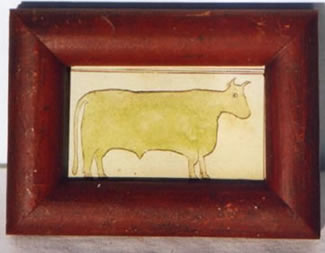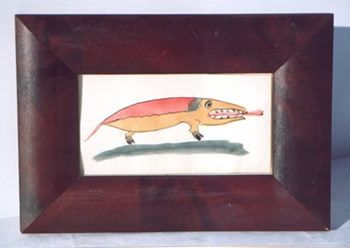The word "fraktur" translates to broken or fractured writing. Pennsylvania German fraktur were handwritten or machine-printed religious illuminations that recorded
births, deaths,  baptisms, and marriages. When the maker of a fraktur was finished with his work, he would often embellish it with naive drawings depicting birds, tulips,
angels, mermaids, soldiers, and various animals. Pre-printed fraktur might include such embellishments, or the person filling in names and dates might add his/her own drawings.
The term fraktur is also applied to Bible verses, other religious writings, or family records that were decorated in the same manner. Now used a little more loosely, today
the term also describes the drawings themselves, even when absent of text. These drawings appear in many places with the lives of early Pennsylvania Dutch immigrants. baptisms, and marriages. When the maker of a fraktur was finished with his work, he would often embellish it with naive drawings depicting birds, tulips,
angels, mermaids, soldiers, and various animals. Pre-printed fraktur might include such embellishments, or the person filling in names and dates might add his/her own drawings.
The term fraktur is also applied to Bible verses, other religious writings, or family records that were decorated in the same manner. Now used a little more loosely, today
the term also describes the drawings themselves, even when absent of text. These drawings appear in many places with the lives of early Pennsylvania Dutch immigrants.
Some come accompany store ledgers as doodles made during times of little activity. Some
appear as doodles on pages of child's homework problems. Math seems to be the most common subject that contains such drawings, although I am uncertain as to why this is
true.  Some accompany copy books, in which children wrote the same sentence over and over to improve their penmanship. In each of the above cases, lack of available paper
on which to draw and paint was sometimes a directly related issue. But some of the fraktur I find are simply stand-alone drawings. Many come from small journals that are
full of such works. Some were executed on bookplates (blank pages at the front of books), while others decorate the interior of book covers. Some were done by teachers as Some accompany copy books, in which children wrote the same sentence over and over to improve their penmanship. In each of the above cases, lack of available paper
on which to draw and paint was sometimes a directly related issue. But some of the fraktur I find are simply stand-alone drawings. Many come from small journals that are
full of such works. Some were executed on bookplates (blank pages at the front of books), while others decorate the interior of book covers. Some were done by teachers as
Teachers were often fraktur artists. There are good reasons why. First, Pennsylvania Germans were not the most well educated group. Farming was the primary profession and did not necessitate strong
reading and writing skills. It stands to reason that teachers were often the persons who could read and write the best. They were also poorly paid and so could supplement their income by completing
fancy birth, baptismal, and marriage certificates. Just because they could write does not mean that they could draw. This is evidenced by the often poor quality of the drawings in fraktur from
the standpoint of a trained artisan, but it is the just this naive nature that interests folk art collectors and can push the value of a fraktur to its maximum potential.
I do buy complete fraktur, but I also buy all manner of fraktur drawings (the
looser definition). The small fraktur drawings I buy can date as early as the late 18th century, and as late as the 1870's or 80's, but the majority I buy date to the period between (the
looser definition). The small fraktur drawings I buy can date as early as the late 18th century, and as late as the 1870's or 80's, but the majority I buy date to the period between
As I have suggested, however, folk quality in color and design are the primary factors affecting price. Also important is the rarity of the subject matter and the name of the artist (if known and
of consequence). Tulips, song birds, and distlefinks (imaginary, parrot-like birds) are the most common subjects. Horses are probably the next most scarce, followed by dogs and eagles. Certain
animals are much more scarce, such as cats, owls, and pigs. Soldiers are much more rare, as are people of any sort. Pennsylvania Germans were taught not to focus on vanity and seldom painted portraits
or depicted themselves or family in drawings. More often, however, they might draw George Washington or some Civil War soldier. Finally, there are certain subjects which are very rare and desired,
such as death angels (figures like you see on 18th century headstones), elephants, and alligators.
Sometimes the name of the artist is known in the case of these smaller drawings, but seldom is the name of great importance or value. The
presence of an actual signature on the work, however, does add interest, even if the person’s identity and history is not known. And writing of any type also adds interest. Both signatures

Mounting: I take great care in the selection of frames used in fraktur drawings. Most often I choose a molding that dates to the same period as the work itself. Early surface is a focus of my selection,
as is color matching or color contrast with regard to the work. Spacers are used to keep the work away from the glass, which is u.v. protective. I use spacers because I have a great dislike for
double-matting, which is seldom seen in the 18th and 19th centuries and has a very 20th century look. I typically choose to instead “float” the drawings. If there is enough of a border
around the work, I will simply allow the acrylic spacers to hold it in place. If the edges of the work need to be shown, I will hinge the drawing with archival tape, mounting it on archival mat
board or acid-free foam core.
|

